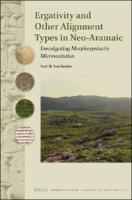Ergativity and Other Alignment Types in Neo-Aramaic
Investigating Morphosyntactic Microvariation
Author(s)
Noorlander, Paul M.
Collection
Dutch Research Council (NWO)Language
EnglishAbstract
The alignment splits in the Neo-Aramaic languages display a considerable degree of diversity, especially in terms of agreement. While earlier studies have generally oversimplified the actual state of affairs, Paul M. Noorlander offers a meticulous and clear account of nearly all microvariation documented so far, addressing all relevant morphosyntactic phenomena. By means of fully glossed and translated examples, the author shows that this vast variation in morphological alignment, including ergativity, is unexpected from a functional typological perspective. He argues the alignment splits are rather the outcome of several construction-specific processes such as internal system harmonization and grammaticalization, as well as language contact.. Readership: All interested in linguistics, especially language typology, syntax and morphology, and contact between languages of the Middle East, particularly Aramaic-Iranian. Examples are fully glossed and translated.
Keywords
Ancient Near East and Egypt; Linguistics; Languages and Linguistics; Language Endangerment & Language Policy; Morphology & Syntax; Afro-Asiatic Languages; Middle East and Islamic StudiesDOI
10.1163/9789004448186ISBN
9789004448186, 9789004448186Publisher
BrillPublisher website
https://brill.com/Publication date and place
2021Imprint
BrillSeries
Studies in Semitic Languages and Linguistics, 103Classification
Grammar, syntax and morphology


 Download
Download Web Shop
Web Shop